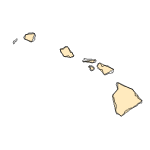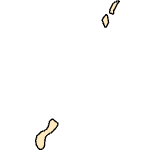Rachycentron canadum
(Cobia)
Fishes
Native Transplant |
|
Common name: Cobia
Synonyms and Other Names: Gasterosteus canadus Linnaeus, 1766; black kingfish, black salmon, crabeater, lemon fish, ling, sergeant fish, bacalao
Taxonomy: available through
www.itis.gov
Identification: Long “torpedo-shaped” body with flattened forebody, silver to dark brown, lower jaw protrudes, tail forked (Humann and Deloach 2002)
Size: to 2 m (Hoese and Moore 1998)
Native Range: Found in all warm seas in the western Atlantic from Massachusetts to Argentina, and throughout the Indian Ocean and western Pacific Ocean from Japan to Australia (Shaffer and Nakamura 1989).



|

Alaska |

Hawaii |

Puerto Rico &
Virgin Islands |

Guam Saipan |
Hydrologic Unit Codes (HUCs) Explained
Interactive maps: Point Distribution Maps
Nonindigenous Occurrences:
Cobia escaped from an offshore aquaculture cage in August 2015 off the coast of Ecuador (Castellanos-Galindo et al. 2016). A few months after the escape, at-large individuals were taken in by fishermen off the Colombian coast, about 600 km from the Ecuadorian escape locality. Fish were also caught down the coast in the Tumbes region of Peru (September - December 2015), and in the Gulf of Panama (October-November 2015).
Table 1. States with nonindigenous occurrences, the earliest and latest observations in each state, and the tally and names of HUCs with observations†. Names and dates are hyperlinked to their relevant specimen records. The list of references for all nonindigenous occurrences of Rachycentron canadum are found here.
Table last updated 1/11/2026
† Populations may not be currently present.
Ecology: Cobia is a carnivorous fish that feeds predominantly on crustaceans but also eats benthic invertebrates and fishes (Shaffer and Nakumura 1998). It is a pelagic, highly migratory fish found in waters 52-1200 m deep and also on coral reefs and in estuaries (Castellanos-Galindo et al. 2016). They are a hardy fast-growing species tolerant of a variety of environmental condition including temperatures from 17-32 °C and salinities between 5-44 ppt (Shaffer and Nakumura 1989, Benetti et al. 2006).
Means of Introduction: Escape from off-shore aquaculture pens (Castellanos-Galindo et al. 2016).
Status: Unknown
Impact of Introduction: Unknown at this time, however Castellanos-Galindo et al. (2016) note: “Due to the predatory nature of the species, it is possible that cobias can alter trophic pathways in pelagic and coastal ecosystems of the region.”
References: (click for full references)
Benetti, D., L. Brand, J. Collins, R. Orhun, A. Benetti, B. O'Hanlon, A. Danylchuk, D. Alston, J. Rivera, and A. Cabarcas. 2006. Can offshore aquaculture of carnivorous fish be sustainable? Case studies from the Caribbean. World Aquaculture 37(1):44-47.
Castellanos-Galindo, G.A., R. Baos, and L.A. Zapata. 2016. Mariculture-induced introduction of cobia Rachycentron canadum (Linnaeus, 1766), a large predatory fish, in the Tropical Eastern Pacific. BioInvasions Records 5(1):55-58. http://dx.doi.org/10.3391/bir.2016.5.1.10
Hoese, H.D., and R.H. Moore. 1998. Fishes of the Gulf of Mexico. Texas, Louisiana, and adjacent waters. 2nd edition. Texas A&M University Press, College Station, TX.
Humann, P., and N. Deloach. 2002. Reef fish identification: Florida, Caribbean, Bahamas. 3rd edition. New World Publications, Jacksonville, FL.
Shaffer, R.V., and E.L. Nakamura. 1989. Synopsis of biological data on the Cobia Rachycentron canadum (Pisces: Rachycentridae). FAO Fisheries Synopsis 153, NOAA Technical Report NMFS 82. National Marine Fisheries Service, Panama City, FL. http://spo.nmfs.noaa.gov/tr82opt.pdf
Other Resources:
FishBase Summary
Author:
Schofield, P.J., and Brown, M.E.
Revision Date: 6/21/2019
Peer Review Date: 3/4/2016
Citation Information:
Schofield, P.J., and Brown, M.E., 2026, Rachycentron canadum (Linnaeus, 1766): U.S. Geological Survey, Nonindigenous Aquatic Species Database, Gainesville, FL, https://nas.er.usgs.gov/queries/FactSheet.aspx?speciesID=2987, Revision Date: 6/21/2019, Peer Review Date: 3/4/2016, Access Date: 1/12/2026
This information is preliminary or provisional and is subject to revision. It is being provided to meet the need for timely best science. The information has not received final approval by the U.S. Geological Survey (USGS) and is provided on the condition that neither the USGS nor the U.S. Government shall be held liable for any damages resulting from the authorized or unauthorized use of the information.